BlueNile Applications
The main applications of the BlueNile software are image processing (pattern suppression & emphasis, image smoothing and edge enhancing) and artefact measurements (frequency of patterns, their slant and quality of the regularity).
This software enables an automatic as well as manual filtering of images in the frequency domain. Therefore it is most appropriate for images with repetitive patterns.
The principal users are scientists, but also the very large public producing digital images.
Application example for the history of paper
Let's take a look at the application of BlueNile for which it was developed: the history of paper.
1. Laid lines suppression
One way of dating medieval texts written on paper is to compare the similarity of the watermark present in the paper to be dated to a watermark of a paper for which the production date is know (from textual evidence for example). Therefore it is necessary to segment the watermarks and discard the other artefacts present in a paper reproduction such as laid lines, chain lines and noise. As a pre-processing step it could be useful to suppress the laid lines and leave the watermark surrounded only by the chain lines and noise. Figure 1 shows the original image (left) along the processed image in BlueNile (right) [settings: elliptical filter shape, power 0, autofiltering, passes 1, spread 10].
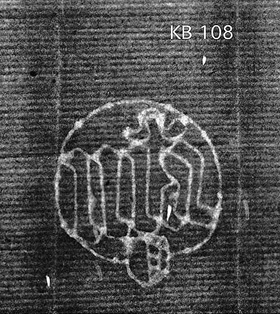 |
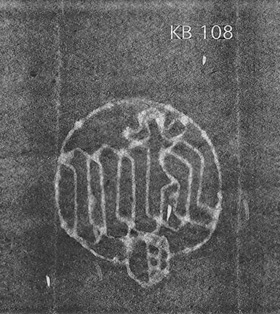 |
Figure 1. Original image of a paper structure (left) and the same with the laid lines filtered out (right). |
|
2. Screen structure enhancement
The images of paper structures produced by various means - betaradiography, electronradiography, photography trough transparency, rubbings - are often speckled with noise or present regions of non-uniform exposure. It is possible to enhance the visibility of the structure by amplifying the same frequencies that in our first example we suppressed. Figure 2 shows the results of such a sharpening filter (same settings, only power set to 3).
 |
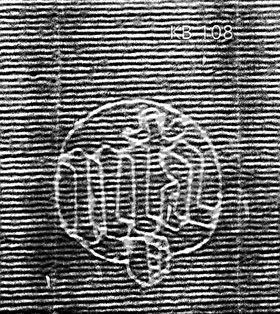 |
Figure 2. Original image of a paper structure (left) and the same with the laid lines amplyfied (right). |
|
Note over the general improvement of the image (helped also by the adjustment of contrast, denoising and evening), how the connexions between the laid lines and the chain lines are clearer and how details in the watermark appear, that were unseen before (the horizontal line in the lower part of the shield, the NW part of the letter <m>).
The resulting image is valuable not only for expertise, but also has a better quality for printing if it is to be published on a paper support.
3. Laid lines extraction
In the same way that the watermarks are segmented from the rest of the image, it is possible to extract the laid lines. This is interesting topic for the researchers of paper, since they would be able to observe screen particularities and evolution. In Figure 3 we see three images of extracted laid lines.
 |
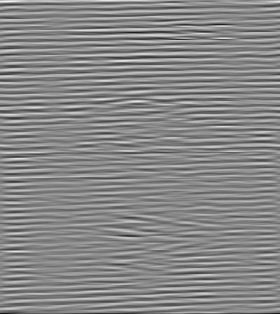 |
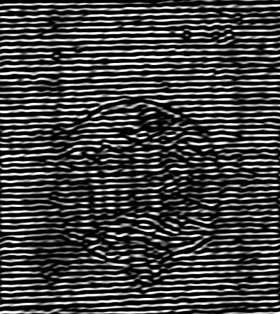 |
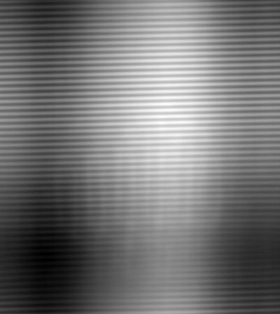 |
Figure 3. Original image of a paper structure (NW) and the extracted laid lines at power 0 (NE), power 3 (SW) and through selffiltering (SE). |
|
The NE image represents what is left of a paper structure if we suppress everything but the laid lines frequency (complementary image of that shown in Figure 1, right, with no adjustment, hence the low contrast). A somehow better image of the laid lines is given by enhancement (complementary image of Figure 2, right, with adjustments). You notice however some strange things: otherwise unconnected laid lines are connected (a laid line jumping over another appears in the SE region of the watermark). These are artefacts introduced by the method of filtering used in BlueNile - the Fourier transform - that tends to make an image more regular than it is. An even stronger 'idealisation' of the papermaking screen is obtained by using another method of filtering in the frequency domain: the selffiltering of the Fourier transform (*) - see the SE image, where the deformation of the laid lines is such that they appear perfectly parallel.
In conclusion the segmentation of laid lines through the Fourier transform give results that still have to wait for their applications and interpretation methods. The enhancement of the screen structure as presented above is currently a better method for the expertise of laid lines.
(*) Bailey D.G. (1997) - "Detecting Regular Patterns Using Frequency Domain Self-filtering", Proceedings of the International Conference on Image Processing, Santa Barbara, California, October 26-29, Vol I, 440-443.
